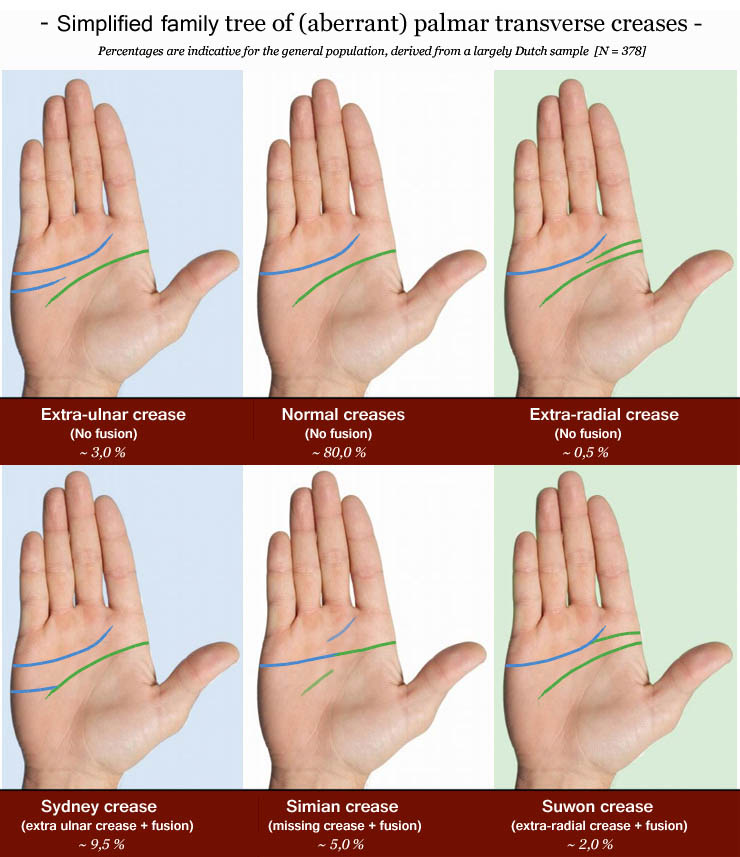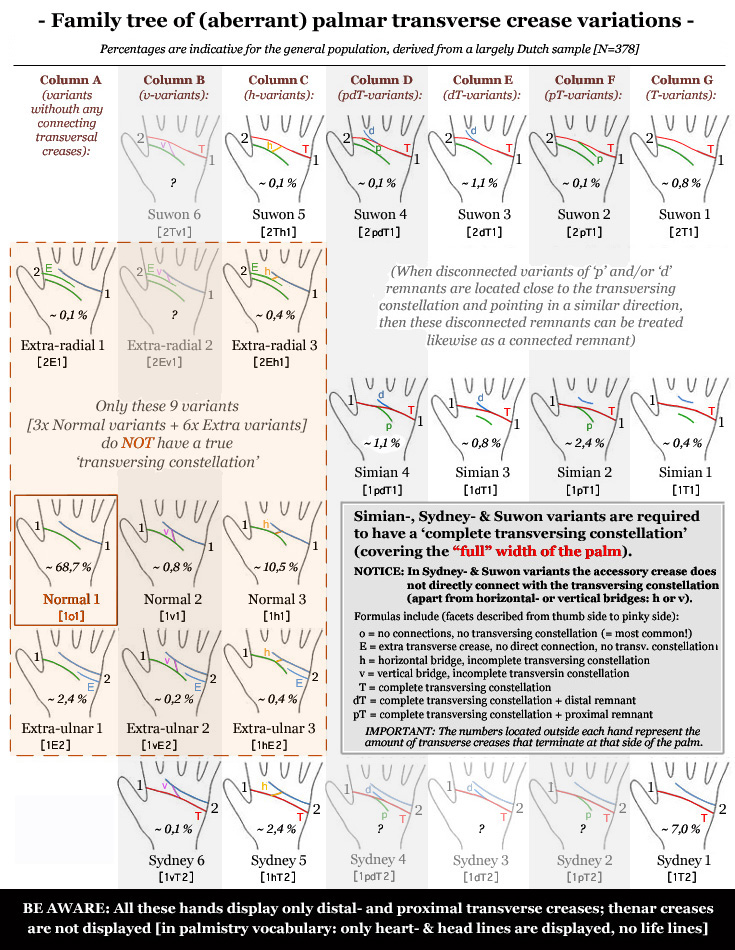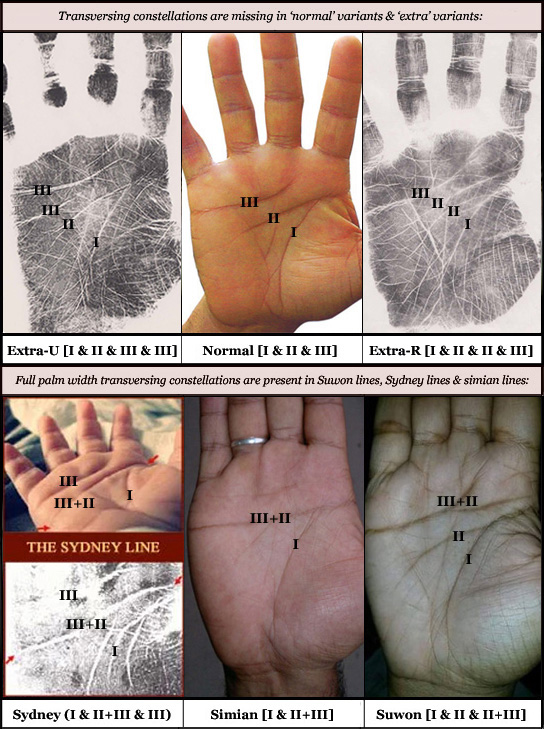
|
MAY 9, 2017 Family tree of (aberrant) palmar transverse crease variations!Most hands have two palmar transverse creases, these are known as the so-called 'distal transverse crease' (a.k.a. heart line) and 'proximal transverse crease' (a.k.a. head line). After Korean researchers presented in 2011 the very first family tree model focussed solely on the two palmar transverse creases, a more advanced family tree is presented in this article, featured with the distribution of it's variants in 21 different populations, including: males vs. females, people grouped by highest acheived education level, mental issues, health issues, and the Big Five personality dimensions!The simple version of the new family tree is displayed above and includes the following six major transverse crease categories: normal creases, simian creases, Sydney creases, Suwon creases, and finally two new transitional categories are introduced: extra-ulnar creases (which involve a transitional category between normal creases and Sydney creases) & extra-radial creases (which involve a transitional category between normal creases and Suwon creases). Additionally, the advanced version of the new family tree is presented below describing sub-variants for each of the six major categories. The distribution of the major categories has so far been studied in a wide range of 21 different populations. NOTICE: An innovative aspect in the new family tree model involves e.g. the introduction of 'vertical groups' - see the columns inside the picture below, where each of the variants represent a variation involving a specific constellation (each constellation is described with a specific set of colors). The significance of the vertical groups & specific variants can also be explored with the advanced family tree data presented in the table in the 2nd part of this article; additionally, in the near future combinations with other hands factors such as the dermatoglyphics wil be explored as well (an example is already available in an earlier report involving the Big Five dimension Neuroticism HERE). 
Simian lines, Sydney lines & Suwon lines are always required to have a (complete) 'transversing constellation' crossing the full palm. Only in Sydney lines and Suwon lines there is also another (normal) accessory line present - which is not supposed to make any direct connection(s) with the 'transversing constellation'. In Sydney lines the accessory line typically involves a normal heart line located separately above the 'transversing constellation', and in Suwon lines the accessory line is typically a normal head line located separately below the 'transversing constellation'. Finally, one should als be aware that a crease can only be recognized to represent a true 'transverse crease' when it has [1] the appropriate location, [2] enough length (= at least half of the palm), and [3] enough width (= at least two times of the epidermal groove width). Remnants represent major transverse crease parts found in the appropriate location but usually these parts do not have enough length to represent a major transverse crease. The table at the bottom of this article presents data involving the distribution for the 6 major transverse crease categories in 21 populations. Nearly all populations show a distribution where normal variants represent the (very) large majority; only in the Down syndrome sample normal variants did not represent a majority. Also, the other five categories have been observed to be present in far most of the studied populations; only in some of the relatively small samples (with less than 60 subjects) not all five categories are present. These findings signal that likely none of the major palmar transverse crease categories has much potential to serve as a reliable specific clue for any of the studied populations, especially when the assessment has been made for just one in any pair of hands. An advanced analysis involving the sub-variants (not shared in this article) has pointed out that some sub-variants do appear to have potenitial for a specific assessment - for example only two of the 378 subjects in the research populations have a 'simian 3' constellation... and both have Down syndrome (while this sample only includes 16 subjects). Nevertheless, in general also the findings regarding the majority of the subvariants also point in the direction that in the perspective of any diagnostic purpose, the highest potential is likely found when the palmar transverse creases of both hands together are taken into consideration, e.g. because factors involving symmetry vs. asymmetry in a pair of hands bare potential to make a significant difference. An illustrative example for this latter point involves both the the heart conditions population [N=11] & Down syndrome population [N=17] - by the way, heart conditions are known to be present in the majority in Down syndrome people - both samples have a very high prevalence of asymmetry between both hands, and only one of these in total 28 subjects (= 3,5%) has a 'normal 1' constellation in both hands, while in the other populations this combination is actually by far most common with a prevalence typically between 40% and 70%. This suggests that especially transversal crease symmetry involving the 'Normal 1' variant may be atypical in people who suffer on heart conditions!??? (head line & heart line combined) in 21 populations! The most apparent tendencies are labeled with colours (referring to: high values & low values) inside the table below: NOTICE: Estimates for the general population inside the table below have been derived from the research population excluding the Down syndrome sample.
NOTE: The order of the palmar crease variants in the table above is ranked from left to right according the prevalence found in the research population [N=378]. Interestingly, the distribution of prevalence in the two sexes shows a consistent tendency difference between males & females: crease manifestations in the palm appear to be much more common on the radial side in females (prevalence of Suwon crease & extra-radial is 56% higher in females), and slightly more common on the ulnar side in males (prevalence of Sydney creases & extra-ulnar crease is 6% higher in males). Interestingly, these tendencies appear to signal a fundamental parallel with a tendency which has very often been reported in the perspective of finger length and 2d:4d digit ratio research, which basically points out that fingers on the radial side of the hand are typically slightly longer in females and fingers on the ulnar side are typically slightly longer in females. Additionally, another significant difference between males & females also becomes manifest in the distribution of simian line variants; the prevalence of simian crease variants is almost 45% higher in males compared to females. Earlier simian crease studies around the world have often produced a similar result - generally, simian lines have been recognized for decades now to be slightly more common among males than females. Finally, details involving the distribution of sub-variants in the populations will be shared later. 
More about the PALMAR CREASES |
|
|
© COPYRIGHT 2002-2017: |